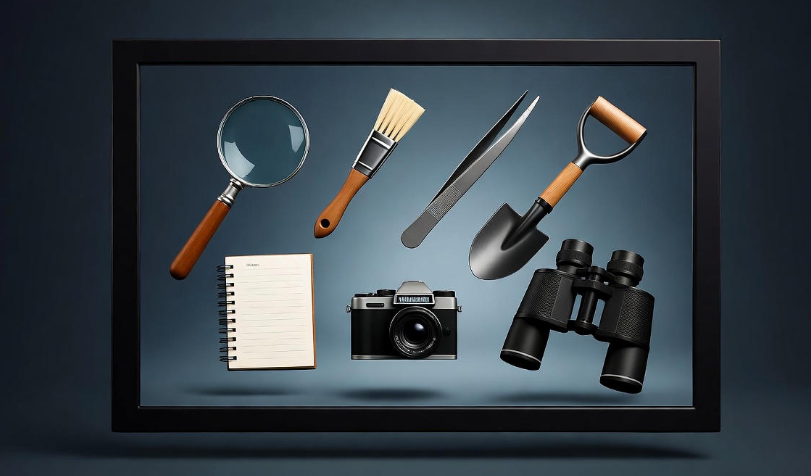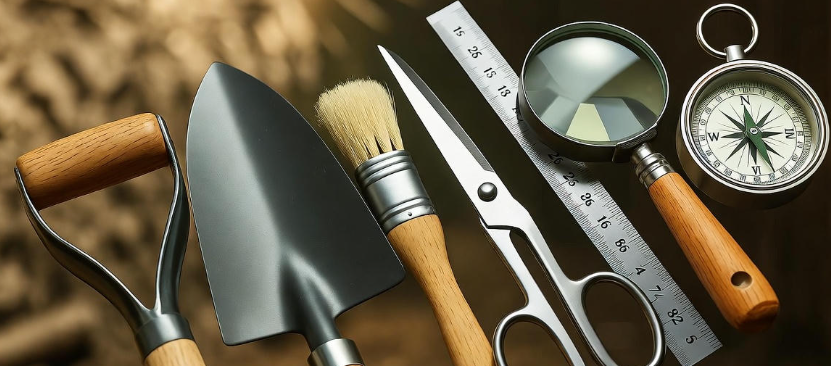When you think of anthropology, you might picture someone sitting under a tree in a faraway village, taking notes in a small brown notebook. 🌍 Well, that’s not entirely wrong — but today’s anthropologists use far more than just pens and paper. They rely on a mix of traditional and modern tools to study people, cultures, and societies in the real world.
These tools help them observe, record, and understand human behavior deeply — from ancient rituals to modern lifestyles. Let’s take a walk through the fascinating toolbox of an anthropologist and see the seven amazing tools they use in their field studies.
1. Field Notebook and Voice Recorder 📓🎙️
It may sound old-fashioned, but a simple field notebook is one of the most powerful tools an anthropologist owns. It’s their companion — always ready to capture quick thoughts, sketches, or observations that might otherwise disappear.
Imagine sitting in a village market, watching how people interact. You notice how they greet, bargain, laugh, or even avoid eye contact. Those moments can’t be captured by memory alone. So anthropologists jot them down immediately — or use a voice recorder to speak their thoughts naturally.
Why both tools?
Because sometimes writing takes time, while speaking feels more natural. Voice recordings also help when working in fast-moving environments or when emotions matter — like during a festival or community meeting.
| Tool | Main Use | Example in Field |
|---|---|---|
| Field Notebook | Writing quick notes, sketches | Describing village rituals |
| Voice Recorder | Capturing real-time speech or interviews | Recording storytelling or chants |
💡 Fun fact: Some anthropologists even name their notebooks — because after months in the field, it feels like a trusted friend!
2. Camera and Video Equipment 📸🎥
If a picture says a thousand words, then a camera says a thousand cultures. Anthropologists use cameras and video recorders to visually document the world they’re studying — not for entertainment, but for analysis.
A single photograph can reveal how people dress, decorate their homes, or perform daily routines. Videos go even deeper — showing movement, emotion, rhythm, and behavior that written words may miss.
Modern field researchers often use lightweight DSLR cameras, GoPros, or even smartphones to capture both stills and motion. Later, these visuals become valuable ethnographic data used for research, teaching, and even museum exhibitions.
But anthropologists are always respectful. Before taking any photo or video, they ask for permission from participants. Ethics matter deeply in this field.
| Tool | Main Purpose | Example |
|---|---|---|
| Camera | Capture cultural practices visually | Traditional dance documentation |
| Video Recorder | Record interviews, ceremonies | Observing social gatherings |
📷 A silent camera often tells a louder story than words ever can.
3. GPS Device and Mapping Tools 🗺️📍
When anthropologists explore remote regions, knowing where they are — and where their participants live — becomes crucial. That’s where GPS devices and digital mapping tools come in.
They use handheld GPS units or smartphone-based apps like Google Earth and ArcGIS to mark important locations, track movement patterns, and understand spatial relationships in a community.
For example, an anthropologist studying water access might mark every well or river on a map, showing how far families walk daily to fetch water. That data tells powerful stories about environmental challenges and human adaptation.
| Tool | Function | Common Use |
|---|---|---|
| GPS Device | Track location and geography | Map villages and travel routes |
| GIS Software | Create digital maps | Visualize cultural and environmental data |
🧭 Field maps aren’t just about directions — they’re about understanding how people move and live within space.
4. Interview Guides and Questionnaires 🗒️💬
Human stories are at the heart of anthropology. To collect those stories, researchers often design interview guides and questionnaires before entering the field.
These are not rigid forms. They’re flexible tools that help keep conversations on track while still allowing natural flow. Anthropologists prefer semi-structured interviews, which means they have questions prepared but let participants talk freely.
Sometimes, instead of direct questions, they use storytelling prompts like:
“Can you tell me about a time when your family celebrated something important?”
This invites real, emotional, and detailed responses — the kind that help anthropologists understand cultural meanings, not just statistics.
| Tool | Purpose | Example Question |
|---|---|---|
| Interview Guide | Keep conversation focused | “How do you teach children community values?” |
| Questionnaire | Collect similar data from many people | “How often do you attend village meetings?” |
🗣️ Good anthropologists listen more than they talk. That’s their secret weapon.
5. Audio and Video Transcription Software ⌨️🎧
After fieldwork, anthropologists return with hours of recordings — interviews, conversations, and cultural performances. But recordings alone aren’t enough. They need to be transcribed — written word-for-word so that researchers can analyze patterns, emotions, and linguistic details.
In earlier times, this was done manually (and painfully slowly!). Today, tools like Express Scribe, Otter.ai, and Trint make the job much faster by automatically converting speech to text.
Still, anthropologists often listen again — carefully editing and verifying words — because local accents, dialects, or cultural references can confuse software. This transcription phase is where much of the deep understanding begins to form.
| Tool | Use | Example |
|---|---|---|
| Otter.ai / Trint | Auto speech-to-text | Interview transcription |
| Express Scribe | Manual editing | Accurate language details |
📝 Every word counts — because in anthropology, meaning hides between sentences.
6. Digital Ethnography Tools and Online Platforms 💻🌐
Modern anthropology isn’t limited to villages or jungles anymore. Today’s field may be online — social media, gaming communities, or virtual meeting spaces.
Digital ethnography tools like NVivo, Atlas.ti, or Dedoose help anthropologists analyze large sets of online or textual data — such as Facebook posts, YouTube comments, or online group discussions.
These tools allow researchers to code data by theme, compare responses, and visualize patterns — revealing how humans form digital cultures, communicate, or build identity online.
| Tool | Main Use | Example Field |
|---|---|---|
| NVivo | Qualitative data analysis | Social media studies |
| Dedoose | Mixed-method data analysis | Online community research |
🌐 Culture lives both offline and online — and anthropologists follow it wherever it goes.

7. Portable Laboratory Kits and DNA Testing Tools 🧬🔬
Yes, anthropology can get scientific too! Especially in biological anthropology, where researchers study human evolution, genetics, and physical variation.
Field anthropologists sometimes carry portable lab kits for collecting and analyzing biological samples — like hair, bone fragments, or soil around ancient burials.
Modern tools like portable DNA sequencers (e.g., Oxford Nanopore’s MinION) have revolutionized fieldwork. Instead of sending samples to distant labs, researchers can now test them right there in the field.
These tools help answer big questions — about migration, ancestry, health, and how humans have adapted to different environments.
| Tool | Use | Example |
|---|---|---|
| Portable DNA Sequencer | Analyze genetic samples | Study ancient migration patterns |
| Field Microscope | Examine small artifacts | Identify bone or plant residues |
🧬 Anthropology connects our cultural stories with our biological roots — science and humanity hand in hand.
A Quick Recap Table 🧾
| No. | Tool | Main Purpose | Modern Example |
|---|---|---|---|
| 1 | Field Notebook & Recorder | Capture thoughts and conversations | Voice Memos, Notebooks |
| 2 | Camera & Video Equipment | Visual documentation | DSLR, Smartphone |
| 3 | GPS & Mapping Tools | Location tracking, spatial analysis | Google Earth, ArcGIS |
| 4 | Interview Guides & Questionnaires | Human interaction, data collection | Paper or digital forms |
| 5 | Transcription Software | Convert audio to text | Otter.ai, Express Scribe |
| 6 | Digital Ethnography Tools | Online research, data coding | NVivo, Dedoose |
| 7 | Portable Lab Kits & DNA Tools | Biological and archaeological study | Portable Sequencer |
Bringing It All Together 🌏
Anthropology is both art and science — it’s about observing with empathy and analyzing with precision. These seven tools reflect that balance beautifully. From notebooks and recorders to DNA kits and digital mapping, each instrument helps anthropologists uncover the deep, complex story of what it means to be human.
Even in our modern, tech-driven world, the core skill of anthropology remains the same: curiosity. Tools may change, but the desire to understand people — their joys, fears, and ways of living — never fades.
So the next time you see someone quietly observing, sketching, or recording in a crowded place — they might just be an anthropologist, searching for pieces of the grand human puzzle. 🧩✨
Frequently Asked Questions (FAQs) 🤔
Q1. Why do anthropologists still use notebooks in the digital age?
Because writing by hand helps capture emotions, small gestures, and personal thoughts in the moment. It’s more personal and reflective than typing.
Q2. What is the most modern tool used in anthropology today?
Digital ethnography platforms like NVivo and online data analysis tools are leading the modern transformation of anthropology, especially for studying online behavior.
Q3. Are all these tools used in every field study?
Not always. The choice of tools depends on the type of anthropology — cultural, biological, linguistic, or archaeological.
Q4. How important is technology in modern anthropology?
Technology has made anthropology faster, more precise, and more global. Yet, personal connection and cultural respect remain at the center of all research.
Q5. Do anthropologists need special training to use these tools?
Yes, especially for handling technical equipment like DNA kits or GIS software. Many universities now include such training in anthropology programs.
Final Thought 💭
Anthropology may study the past, but it constantly evolves with the present. These tools — simple or high-tech — help keep its heart beating. They turn curiosity into knowledge and stories into understanding.
At the end of the day, anthropology reminds us that every culture, every person, and every small gesture carries meaning. And with the right tools, we can learn to see that meaning more clearly than ever before. 🌿📚✨

Leave a Reply